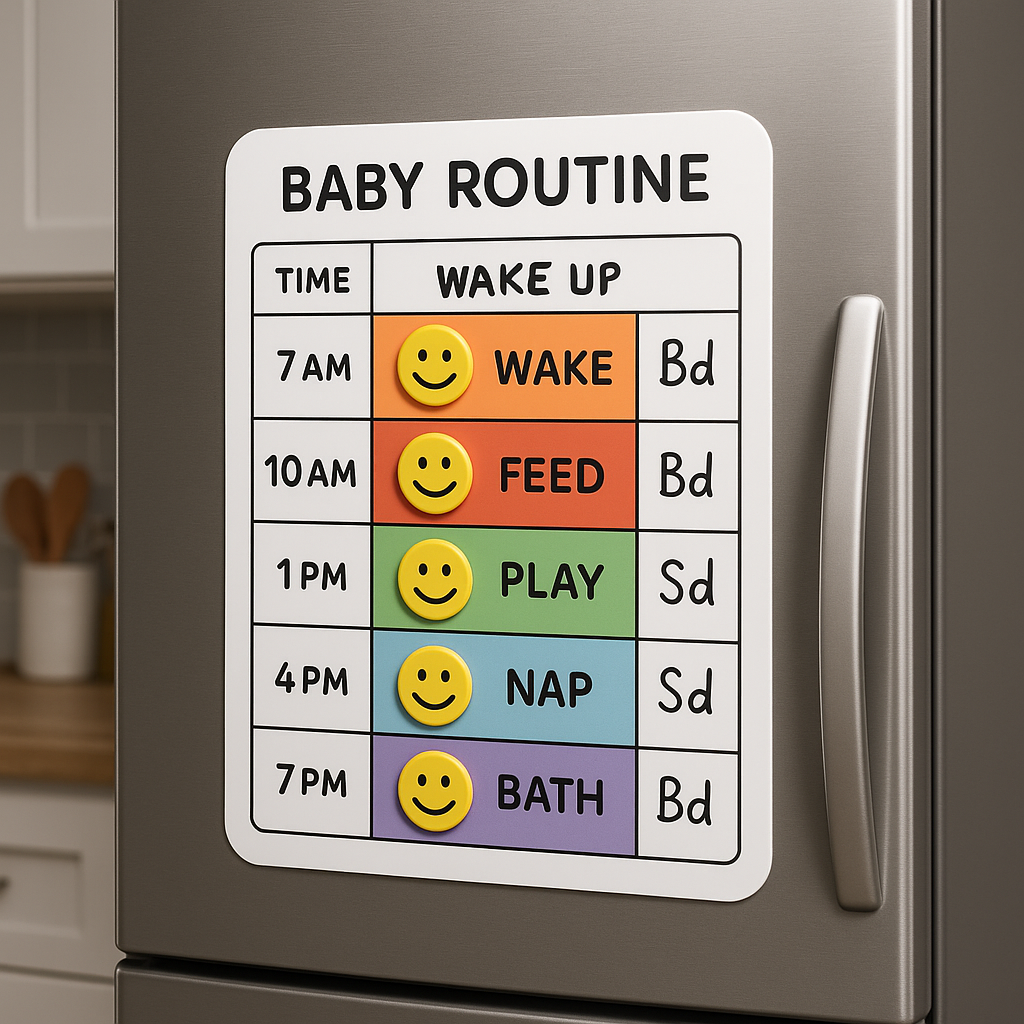Every 60 seconds, your baby’s brain forges up to 1,000 new neural connections. That lightning-fast growth means every cuddle, song, and spoonful can become brain fuel—if the day is arranged to make the most of it. Below you’ll find a flexible sample routine plus science-backed tips that weave brain-boosting moments into ordinary care.
- How does a predictable (yet flexible) routine supercharge your baby’s neural growth?
- What does an evidence-based, hour-by-hour “brain-boosted” day look like?
- How can you adapt the routine for growth spurts, working parents, or multiple caregivers?
- Your top questions—fast answers
- What hidden gaps do most guides miss—and how can you fill them?
- Final Thoughts
How does a predictable (yet flexible) routine supercharge your baby’s neural growth?
A steady rhythm lowers stress hormones, letting the brain focus on learning. Studies show babies in consistent routines reach self-regulation and early language milestones sooner. See how household routines moderate infant cortisol levels: Review infant-family routines and cortisol study.
Predictability creates safety. When naps, feeds, and play happen in roughly the same order, cortisol stays low, and synaptogenesis—building new connections—stays high. At the same time, flexibility matters: watch “wake windows” (about 60 min for newborns, 90–120 min by 4 months) and shift blocks when growth spurts or teething shorten alert spans.
For a deeper dive into why structure matters, see Baby Routines: Do They Boost Brain Development?.

What does an evidence-based, hour-by-hour “brain-boosted” day look like?
Below is a template for a 4- to 6-month-old. Adjust times to suit your baby’s natural rhythm.
| Time | Routine Block | Brain-Boosting Why |
|---|---|---|
| 6:30 AM | Sunlight & Snuggles | Morning light sets circadian rhythm; naming “Good morning sun!” fires visual and language circuits. |
| 7:00 AM | Responsive Feed | Describe taste, color, temperature—linking senses to words and supporting the gut-brain axis. |
| 7:30 AM | Tummy-Time Talk (5–7 min) | Strengthens neck/core and builds spatial pathways. Place a high-contrast card or safe mirror for extra visual stimulation. Tummy Time and Infant Health Outcomes |
| 8:15 AM | Nap 1 | Sleep consolidates new memories; a short lullaby cue anchors recall. |
| 9:00 AM | Sensory Swap | Offer soft cloth vs. crinkly paper; name each texture to map the somatosensory cortex. |
| 10:30 AM | Outdoor Stroll | Natural sounds and sight words (“blue car,” “chirping bird”) expand vocabulary and calm the limbic system. |
| 12:00 PM | Feed & Social Smile | Face-to-face “serve and return” encourages babble imitation and emotional bonding. (Discover how back-and-forth “serve and return” shapes brain wiring: Guide to serve and return |
| 1:00 PM | Nap 2 | White noise prevents overstimulation during light sleep cycles. Learn more in Overstimulation vs. Boredom. |
| 2:30 PM | Music & Movement | Gentle bouncing to a 60–80 BPM song primes auditory and vestibular networks. |
| 3:00 PM | Quiet Book Break | Shared reading—even a board book—builds phonemic awareness and attention span. |
| 4:00 PM | Short Nap 3* | *Often dropped by 8–9 months as wake windows lengthen. |
| 5:00 PM | Messy Play Meal Prep | Let baby mash avocado—fine-motor practice plus choline and zinc for neural insulation. |
| 6:00 PM | Bath-Time Science | Splash, pour, label “sink / float” to seed early STEM vocabulary and cause-effect reasoning. See Modeling Learning. |
| 6:45 PM | Bedtime Routine | Massage, dim lights, lullaby. Predictable cues trigger melatonin and emotional security. A calmer caregiver (see Parental Stress) improves sleep quality. |
*Tip: Replace any block with age-appropriate alternatives—crawl practice, stacking cups, or peekaboo—as your child grows.
How can you adapt the routine for growth spurts, working parents, or multiple caregivers?
Change is inevitable, but you can keep the brain-building core intact.
- Growth-spurt tweaks: Shift naps or feeds by ±30 minutes. Watch cues first, clock second. Cluster-feeding days are temporary; keep anchor rituals like the bedtime song constant.
- Split-shift parenting: Anchor three shared rituals—morning greeting, dinner chat, bedtime story—so baby experiences consistency even when caregivers swap. More on balancing jobs and bonding in Work-Life Balance.
- Multi-caregiver log: Use a simple notebook or app for “serve-and-return wins” (e.g., “Mimi read Brown Bear at 10 AM”). Consistent language input matters more than who delivers it.
- Parental-self-care: Research shows a five-minute adult breather (stretch, deep breaths) lowers cortisol and leads to warmer infant interactions the next hour.

Your top questions—fast answers
-
What if my baby hates tummy time?
Start chest-to-chest, add a mirror, and aim for several 3-minute bursts. Gradual exposure often turns resistance into curiosity. -
Does any screen time help a baby’s brain?
Only live video chat under 18 months shows developmental value. For richer alternatives, visit Screen-Free Parenting. -
How much direct play is “enough” each day?
Five focused 5–10 minute sessions beat one long block. Quality trumps duration—see Quality vs. Quantity Time. -
How do I spot overstimulation?
Gaze aversion, hiccups, or clenched fists signal “I’m done.” Dim lights and offer a cuddle break. -
Can relatives join without derailing the routine?
Yes—share your anchor rituals list. More tips in Family Involvement.
What hidden gaps do most guides miss—and how can you fill them?
- Nutrition timing: Pair iron-rich solids with post-nap alertness for better absorption and engagement.
- Parent wind-down: A nightly 10-minute stretch or journal lowers adult cortisol, making tomorrow’s interactions warmer.
- Travel routine hack: Carry three constants—same lullaby, same lovey, same bedtime phrase—to preserve neural associations anywhere.
Final Thoughts
A baby’s brain doesn’t wait for a special class or fancy gadget—it grows in the rhythm of everyday life. By layering tiny, research-backed interactions onto feeding, naps, and play, you turn each ordinary moment into a neural goldmine. Ready for more ideas? Download the printable schedule and explore Creating a Brain-Boosting Home. Enjoy the journey—you’re wiring a future filled with curiosity and confidence.